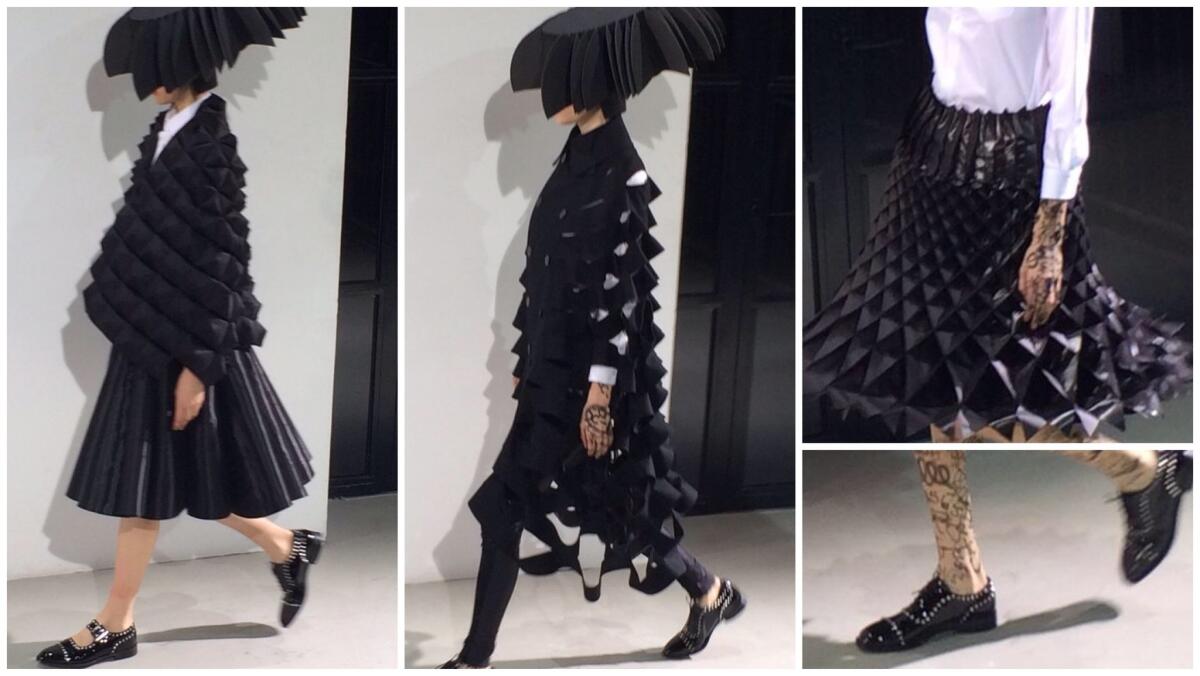Is this the future of fashion? In Paris, Junya Watanabe gives us a lot to chew on

- Share via
Reporting from Paris — At his superb show early Saturday morning at Paris Fashion Week, Junya Watanabe gave us a lot to chew on-- lampshade-looking headgear, graffiti body makeup and the future of fashion as we know it.
Watanabe explored the idea of surface texture, folding and molding, cutting and shaping fabric like paper origami. The resulting honeycombs, pleats, spikes and nets became skirts, dresses, shawls, even trim on the backs of biker jackets.
It was fascinating to think about the technique involved, and what it all means to the bigger picture. This season, the flattening of fashion has been a topic of discussion, as in designers creating clothes to play well on screens, where shoppers are increasingly viewing and buying fashion.
More Paris Fashion Week: Booth Moore’s Photo Sphere diary | The fierce women of PFW | Rick Owens and Lanvin outshine Kim Kardashian
In one sense, Watanabe’s collection ran counter to this theory, in that it was all about angles, architecture and taking up space. (The models’ bodies were even “tagged” with graffiti like the facades of buildings).
But, like paper origami, many of the clothes could easily be flattened out. Besides the fact that it could be awfully handy for packing, flat, foldable, expandable clothes also bring to mind the potential of 3D printing. Just run a program, or scan an image, and voila! Out pops a dress!
Forget social media and cellphone shopping; when it really goes mainstream, 3D printing will be fashion’s biggest challenge yet.
Elsewhere on the runways on Friday afternoon and Saturday, the shows were just shows and the clothes were just clothes.
Looking at the crazy street style of the fashion crowd in Paris, in their oversized coats, funny hats and clodhopper shoes, is one thing. But when you talk to store buyers about what women really want (and not just to gawk at from home on computer screens, but in real life) they say it’s to feel comfortable and sexy. Hence the popularity of labels Isabel Marant, and the re-energized Mugler; Marant for when you want to impress your girlfriends, and Mugler for when you want to impress the guys.
What Marant does so well is elevated boho basics. The clothes don’t change that much from season to season, but they feel good, and you want to hang out in them.
Sirens and sailors was the vibe of Marant’s fall collection. She gave her covetable sporty-chic look a nautical spin, starting with piling on domed brass buttons, which appeared on everything from the fronts and sides of jeans, to the season’s new ankle boots with stacked heels.
Cable knits sweaters with peaked shoulders and a slim fit were tucked into super high waist sailor jeans for a look that was cute and cozy. (Unlike many designers who have embraced the wide-legged trouser this season, Marant kept things skinny.) Lace-up blouses, swishy ikat miniskirts, and striped marine sweater dresses worn with swashbuckling, over-the knee boots added a siren’s sexiness.
Young talent David Koma showed a confident second collection for Mugler. While it didn’t make any fashion news, it did flatter all the right places.
Sexy tailoring included sharp peplum blazers contoured with rows of sequins or panels of leather, and curve hugging corseted tops over slim pants
Crepe mini dresses dotted with metal grommets exposed a hint of flesh, while short skirts glinted with mirrored hardware, not the car fins of Mugler’s era in the ‘80s, but rather the stuff of computer circuit boards. Koma is at least upholding the legacy of the house founder for body contouring, if not for boundary pushing.
The future of Nina Ricci’s legacy is less clear. After designer Peter Copping was tapped to helm Oscar de la Renta last year, a French designer named Guillaume Henry was hired to replace him.
Henry showed his first collection on Saturday night, and it was more queen mum than French coquette. See-through lace dresses do not a sexy look make, and sober, mannish tweed coats aren’t going to cut it at a house so firmly associated with sweet romanticism. Save for a couple of starry sequin dresses, this debut collection was a miss. Even the shoes, uninteresting low heeled suede pumps, were a snooze.
I’ve got the latest Tweets from seats -- and more -- @Booth1
PHOTOS FROM PARIS FASHION WEEK:
Booth Moore’s Photo Sphere diary
Highlights: Style, celebrities and spectacle







